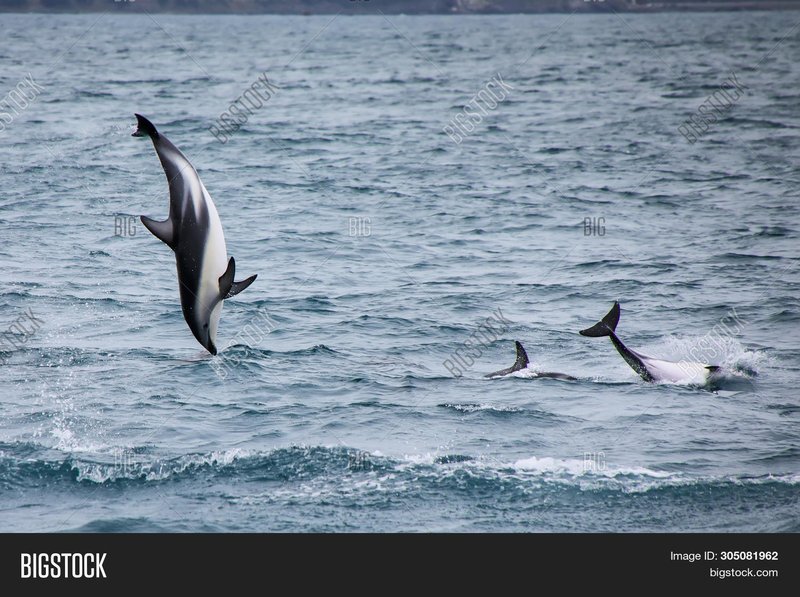
Have you ever seen a dolphin leap gracefully through the waves? The Dusky Dolphin is one of nature’s most charming performers, captivating onlookers with their acrobatic displays. These playful creatures, known for their energetic spins and jumps, inhabit coastal waters, primarily in the Southern Hemisphere. If you’re curious about what makes these dolphins so special, you’ve come to the right place!
Dusky Dolphins are not just pretty faces. They are highly intelligent and social animals, often found swimming in groups. Their playful interactions with one another can be a delightful sight, reminiscent of children playing in a park. But there’s so much more to these dolphins than meets the eye! Let’s dive deeper and learn all about their fascinating world.
Physical Characteristics
Dusky Dolphins are easily identifiable thanks to their distinctive appearance. You might notice their sleek bodies that can reach lengths of up to 2.6 meters (about 8.5 feet). Their skin is typically a beautiful mix of gray and white, with a darker back and lighter underbelly, which helps them blend seamlessly with their ocean surroundings. Think of them as the ultimate stealth swimmers.
One of the most remarkable features of Dusky Dolphins is their unique dorsal fin. It is tall and curved, which gives them an elegant silhouette as they glide through the water. Their pectoral fins are also quite long and slender, allowing them to maneuver easily. This combination of physical traits turns every jump and flip into a breathtaking show!
Habitat and Range
Dusky Dolphins prefer to live in coastal areas, particularly in waters that are cool to temperate. You can often find them along the shores of South America, New Zealand, and even parts of Africa. They prefer regions where the water is rich in nutrients, which provides an abundant food supply. So, if you’re looking to catch a glimpse of these lovely dolphins, heading to the coastal regions of these areas can offer a great chance!
These dolphins are also quite adaptable. They can thrive in both deep offshore waters and shallower coastal zones. This versatility allows them to follow schools of fish, which make up a significant part of their diet. Whether they are surfing the waves or hunting for lunch, Dusky Dolphins truly know how to make the most of their environment.
Diet and Feeding Habits
You might be wondering: What do Dusky Dolphins eat? Well, they have quite the varied diet! These dolphins primarily feed on fish and squid, often forming cooperative hunting groups to catch their prey. Picture a team of dolphins working together, herding fish into tight balls, making it easier for them to snatch a meal!
One interesting behavior is known as strand feeding. This is when Dusky Dolphins swim in shallow water to chase fish onto the beach. They leap out onto the sand, briefly leaving the water to catch their prey. It’s a daring strategy that reminds us of how clever and resourceful these dolphins can be. Their ability to adapt to different feeding techniques truly showcases their intelligence.
Social Structure and Behavior
Dusky Dolphins are social creatures. They live in groups called pods, which can consist of anywhere from a few individuals to hundreds! These pods are often playful, filled with lots of jumping and flipping, making it a joyous scene. Communication among these dolphins is vital; they use a combination of whistles, clicks, and body language to interact with one another.
You might be surprised to learn that they often exhibit behaviors similar to those of humans. For example, they have strong bonds within their pods and can even be seen playing with each other or with other species, like sea birds. Their playful nature adds an extra level of charm to their personality, making them one of the most loved marine mammals.
Reproduction and Lifespan
Now, let’s talk about how Dusky Dolphins bring new life into the world. The mating season usually peaks during the warmer months. After a gestation period of about 11 to 12 months, a calf is born, typically measuring around 1 meter (3.3 feet) in length. It’s fascinating how much care they receive from their mothers, who nurse the calf and teach it valuable survival skills.
Calves will stay with their mothers for at least a year but can remain part of the pod much longer. As for lifespan, Dusky Dolphins can live to be about 15 to 20 years old in the wild, which is quite impressive for marine mammals. It highlights the importance of protecting their habitats to ensure future generations can thrive.
Conservation Status
While Dusky Dolphins are indeed delightful, their populations face challenges. The main threats include habitat degradation, fishing practices, and pollution. Unsustainable fishing can result in accidental catches known as bycatch, where dolphins become entangled in fishing gear. This not only poses a risk to their survival but disrupts the entire ecosystem.
Conservation efforts are underway to protect these remarkable creatures. Creating marine protected areas and implementing sustainable fishing practices can help ensure that Dusky Dolphins continue to swim the seas for generations to come. It reminds us how crucial it is to be responsible stewards of our oceans, protecting these amazing animals and their habitats.
Interesting Facts about Dusky Dolphins
| Size: | Up to 2.6 meters (8.5 feet) |
| Weight: | Between 60 to 80 kilograms (132 to 176 pounds) |
| Speed: | Up to 55 km/h (34 mph) |
| Diet: | Fish and squid |
| Lifespan: | 15 to 20 years |
| Social Structure: | Lives in pods of varying sizes |
FAQ
What is the scientific name of the Dusky Dolphin?
The scientific name for the Dusky Dolphin is Lagenorhynchus obscurus. This name helps researchers identify and study this particular species within the broader category of dolphins.
Are Dusky Dolphins friendly towards humans?
In general, Dusky Dolphins are curious and often playful in the presence of humans. They have been known to approach boats willingly, exhibiting their acrobatic skills. However, it’s important to treat them with respect and maintain a safe distance to avoid disrupting their natural behaviors.
How fast can Dusky Dolphins swim?
Dusky Dolphins are remarkably agile swimmers, capable of reaching speeds of up to 55 kilometers per hour (34 miles per hour). Their speed allows them to perform stunning acrobatics and evade predators. Watching them swim is like witnessing a dance in the water!
What are the main threats to Dusky Dolphins?
The primary threats facing Dusky Dolphins include habitat degradation, bycatch from fishing practices, and pollution. These factors can significantly impact their populations and overall health. Efforts are being made to mitigate these threats and promote their conservation.
Can you see Dusky Dolphins in aquariums?
While Dusky Dolphins are often found in the wild, they are not commonly kept in aquariums. This is due to their specific habitat needs and their preference for living in open waters. Conservationists believe it’s best to observe them in their natural environment.
Do Dusky Dolphins have any natural predators?
Yes, Dusky Dolphins can sometimes fall prey to larger marine mammals, such as orcas. However, their speed and agility often help them evade threats. They rely on their intelligence and social behavior to stay safe.
How do Dusky Dolphins communicate?
Dusky Dolphins use a variety of sounds, including whistles and clicks, to communicate with one another. They also use body language, such as breaching or tail slapping, to convey messages. This complex communication system plays a vital role in their social structure.
Do Dusky Dolphins migrate?
Dusky Dolphins are not known to migrate long distances like some other marine mammals. Instead, they tend to stay within specific coastal areas where they find sufficient resources. They may move slightly in search of food but generally remain in the same region.
Are Dusky Dolphins protected by law?
Many countries have implemented laws and regulations to protect Dusky Dolphins and their habitats. These legal protections aim to reduce human-related threats and ensure the sustainability of their populations. Conservation organizations also play a significant role in advocating for their protection.
How can I help protect Dusky Dolphins?
You can help protect Dusky Dolphins by supporting conservation efforts, reducing plastic use, and advocating for sustainable fishing practices. Every small action counts in preserving their habitats and ensuring their survival in the wild.

